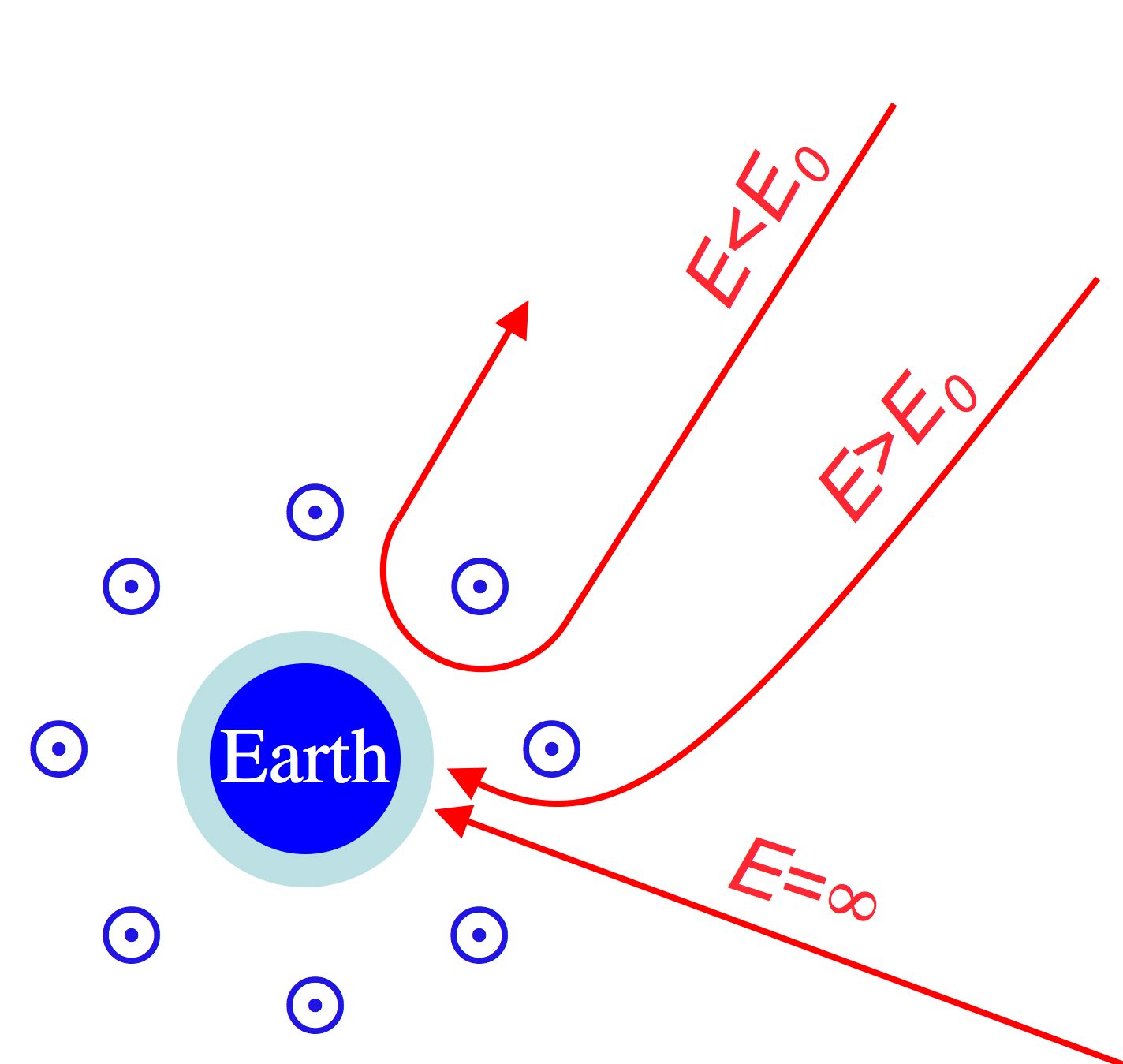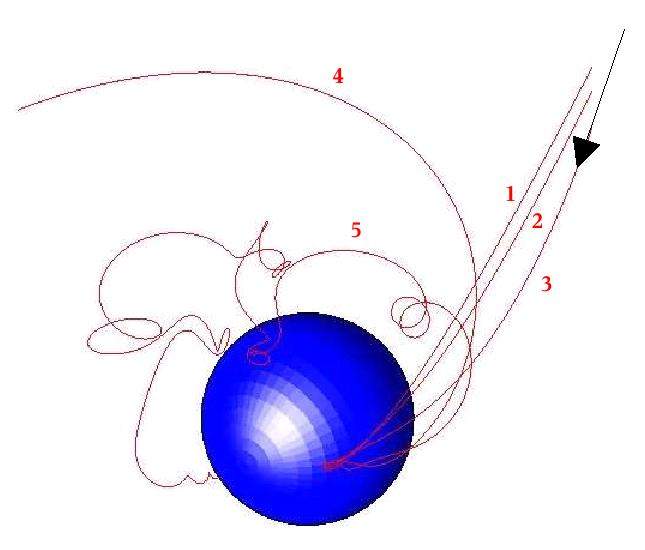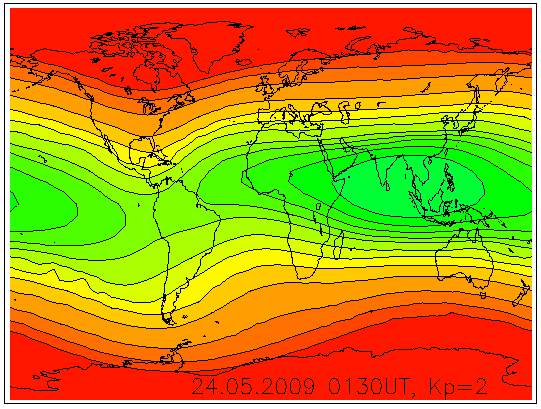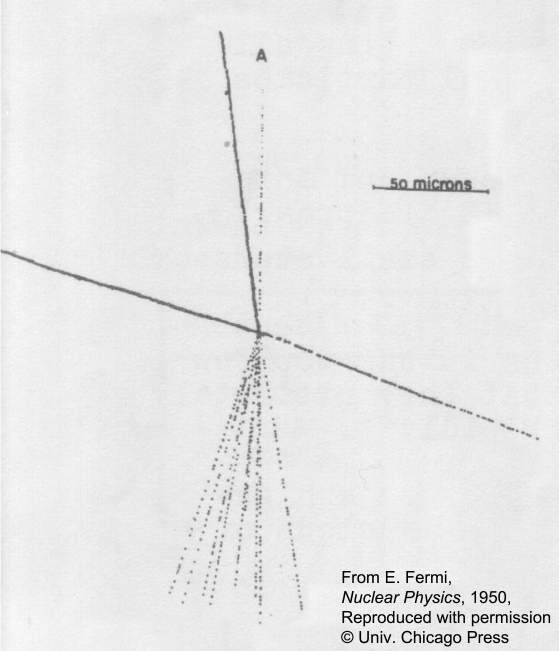Cosmic rays and the Earth
On their way to Earth cosmic rays encounter the Earth's magnetic field and, if they succeed to go beyond, the atmosphere. The magnetic field is shaped by electric currents in the Earth's core and by the solar wind. Cosmic rays coming from outside will undergo complicated trajectories in the magnetic field and may even be prevented from getting access to the atmosphere, if their energy is too low. The filtering by the magnetosphere gives us the possibility, using neutron monitors at different locations, to derive the spectra and arrival directions of cosmic rays.
When the cosmic ray enters the Earth's atmosphere, it encounters atoms and molecules, especially nitrogen and oxygen. Collisions will create secondary particles of different energies. Some of them may reach the ground, where one can measure them and infer the properties of the primary cosmic rays. Neutron monitors are one type of instruments which use this technique.
Cosmic rays and the Magnetosphere
The Earth's magnetosphere
The Earth has a magnetic field, which is generated by electric currents in its core. If the Earth were located in empty space, the magnetic field outside its body would be similar to that of a bar magnet, a dipole, located somewhat off the centre of the Earth, and inclined with respect to its axis of rotation. This picture does indeed describe the magnetic field up to some distance of about five Earth radii from the centre. But the Earth is exposed to the continuous flow of charged particles of the solar wind. This flow compresses the magnetic field lines on the sunward side of the Earth, and extends them into a long magnetic tail on the night side. The field lines are the thick light blue lines in the Figure. They form a nearly closed system around which the solar wind flows as indicated by the light lines. The cavity that the Earth's magnetic field thus creates in the solar wind is called the magnetosphere (note that the inclination of the Earth's dipole is not represented in the figure).
The border of the magnetosphere on the sunward side is at a distance of 10-12 Earth radii from the Earth's centre, while the tail of the magnetosphere extends over at least 100 Earth radii into the anti-sunward direction, as a cylinder with diameter 60 Earth radii. This configuration is determined by the solar wind flow. The body of the Earth makes its daily rotation with respect to the magnetosphere, so that we have the sunward boarder of the magnetosphere above our heads at local noon, and look into the tailward direction at midnight. Since the Earth's dipole axis is inclined with respect to its axis of rotation, the magnetic field varies in a complex manner at fixed geographic location, even when solar wind conditions are stable. The varying solar wind introduces further variations, as we will see below.
Charged particles and magnetic fields

An electrically charged particle is deviated by a magnetic field. The magnetic force is perpendicular to both the magnetic field line and the velocity of the particle. So if we have a straight magnetic field line and a charged particle propagating along the field line, no force will be exerted. But if the particle propagates in a plane perpendicular to the field line, it will be forced into a circular orbit. In the general case, where the particle has a motion both parallel and perpendicular to the magnetic field line, its trajectory will be the combination of uniform motion along the magnetic field and circular motion perpendicular to it. This is a helical trajectory.
The schematic drawing shows how a proton orbits around a magnetic field line. The radius of its circular orbit depends on the magnetic field and the energy of the particle: the stronger the magnetic field and the weaker the energy of the particle, the smaller is the radius of its orbit. If the magnetic field is weak or the particle energy very high, the particle will ignore the magnetic field and propagate along a straight line. Electrons are also subject to the magnetic force, but due to their negative charge they turn in the opposite sense of the protons. Also, because of their smaller mass, the radius of their orbit is smaller than that of the proton.
For a mathematical description, look here. If you want to see how magnetic fields shape the trajectories of charged particles, try to play bowling.
Charged particles and the Earth's magnetosphere

We can use the above reasoning to understand how cosmic ray particles behave when they approach the Earth's magnetosphere. This schematic drawing shows the Earth as seen by an observer above the northern pole. We need not consider the particularities of the Earth's magnetic field for a first understanding of how it affects cosmic rays. In this Figure the magnetic field, symbolised by the blue circles, points out of the plane of the drawing, towards the spectator. We assume, to make the reasoning simpler, that the cosmic ray particle travels through empty space, without any magnetic field, until it encounters the magnetosphere at some distance from the Earth. Of course there is some magnetic field in interplanetary space, but it is much weaker than in the magnetosphere, and we need not consider it here.
There are three types of orbits, depending on the energy of the incoming particle:
- If the incoming cosmic ray proton has a very high energy, it will travel along a nearly straight line down to the atmosphere.
- If it has too weak an energy (E < E0), its trajectory will be bent by the magnetic field into a semi-circle with such a small radius that the proton will not reach the atmosphere. It will undergo half an orbit around the field line and then find itself outside the magnetosphere again. That means it will be reflected back into the interplanetary space.
- Particles at intermediate energies reach the atmosphere along a curved path. The curvature is the stronger, the lower the energy - down to the geomagnetic cutoff E0 where no particle gets access to the atmosphere.

What actually happens depends on the latitude and the inclination at which the cosmic ray encounters the magnetosphere: around the poles is a small region where the magnetic field lines are more or less radial. If the particle comes in radially there, it will have unhindered access to the atmosphere. If it encounters the magnetosphere in the equatorial plane, it hits the magnetic field where its shielding is most effective, and the cutoff energy E0 the highest. Particles with energies just above the cutoff may have a very complex orbit before they reach the atmosphere. The Figure (MAGNETOCOSMICS code, L. Desorgher, Univ. Bern) shows computer-calculated trajectories for different energies, which decrease from the curves labelled (1) to (5). The latter curve illustrates the complex magnetospheric trajectories of particles near cutoff.
The complex particle trajectories in the magneosphere must be taken into account in the interpretation of charged particle measurements from the Earth: instruments like neutron monitors count all particles above the threshold E0 defined by their location and the status of the geomagnetic field. Most important are those particles, which hit the top of the atmosphere vertically. Particles coming in at some angle produce less secondaries that can be detected at the ground, because they have a longer path through the atmosphere and become more strongly absorbed. The drawing shows that the arrival directions of the particles outside the magnetosphere at a given point on top of the atmosphere depend on their energy: the lower the energy, the farther away is the original arriving direction from the local radial. In the equatorial plane the particles come in from more and more eastward direction as the energy decreases. A more detailed discussion of arrival directions is given here.

A map of cutoff energies as calculated in real time at the University of Bern is shown in this Figure. Red shading at the borders of the map is for regions where protons with energy below 125 MeV can penetrate to the atmosphere (20 km above the ground), while energies above 15 GeV (green colour within the closed contour) are required in equatorial regions above southern Asia. The contours of equal cutoff energy are curved, because the axis of the terrestrial magnetic field is inclined with respect to the rotation axis. Overall one notes that the closer one approaches the magnetic equator, the higher the minimum energy required for cosmic rays to reach the atmosphere. The cutoff energies are higher within the closed contour above southern Asia, because the Earth's dipole is located somewhat outside the centre of the Earth, closer to southern Asia than to the region on the opposite side of the Earth above the western Atlantic Ocean.
The Earth's magnetosphere hence introduces two kinds of effect that are important for neutron monitor observations:
- the low energy cutoff,
- the asymptotic arrival directions of the incoming particles.
Both depend on the geographic location of the neutron monitor. By combining observations from different neutron monitors on the Earth we can therefore derive information on the energy spectrum of the incoming cosmic rays and on their direction of propagation in space, before they hit the Earth's magnetosphere.
The variable magnetosphere
We have seen elsewhere that the solar wind is not a stationary flow, but that it has a slow and a fast component, and supplementary perturbations from coronal mass ejections. All these features affect the Earth's magnetosphere, since they make the solar wind pressure on the Earth's magnetic field vary. While the border of the magnetosphere on the sunward side is at about ten Earth radii above ground in quiet times, it can approach as close as six Earth radii when the magnetosphere is hit by a powerful interplanetary event. The weak interplanetary magnetic field, which is usually distinct from that of the Earth, can under certain conditions reconnect with the magnetic field of the Earth, whereby solar wind particles penetrate into the magnetosphere. The changing solar wind conditions therefore change the configuration of the magnetosphere, and also the conditions under which cosmic rays get access to the atmosphere.
Cosmic rays and the Atmosphere
As a cosmic ray enters the Earth's atmosphere, it encounters an increasing number of atoms and molecules, especially nitrogen and oxygen. Sooner or later the cosmic ray will collide with one of them. It can interact both with the electronic cloud (which has a diameter of 10-10 m for an atom) and with the much smaller nucleus (with diameter of 10-14 m).
Because of the different sizes and the range of the interactions, the most frequent collisions involve the electronic cloud. Electrons are torn off by the electric field of the cosmic ray, and the atom or molecule gets ionised. Since electromagnetic forces act over large distances, ionisation is frequent, but the energy loss of the incoming proton is minor in an individual interaction, and plays no role in the high atmosphere.
The impact of a high energy nucleon on an atomic nucleus
Interactions with the atomic nucleus create a wealth of phenomena and new particles, which were discovered through the study of cosmic rays, and can now be reproduced in large particle accelerators. Nuclear interactions have a very small range, comparable to the size of the nucleus, and occur less frequently than ionisation. But they affect considerably the incoming particle and destroy the target nucleus.

A nice way to visualise the interactions is to observe the tracks of charged particles in a special type of photographic emulsion. An ionising particle excites the silver bromide molecules that it encounters along its path. When the photographic plate is developed, it shows the track of the particle. This Figure is an example (from E. Fermi, Nuclear Physics, Fig. X.4a, University of Chicago Press 1950). We see that different tracks emanate from one point, which is the target nucleus. The primary nucleon was in this case a proton of energy about 5 GeV, travelling at 98% of the speed of light. Its track is the vertical line in the upper half of the photograph, labelled A. The thin lines pointing downward from the target nucleus are particle tracks within a narrow cone around the direction of the incident high-energy proton. The tracks are produced by pions and high-energy protons kicked off the target nucleus. Since they are very fast, the distances between sensitised silver bromide molecules are big, and the tracks are faint on the photograph. The three thick black lines are the tracks of slower protons that are ejected in arbitrary directions.
This pattern reveals two types of interaction:

- If the energy of the incident particle is sufficiently high, it hits one or two individual nucleons in the target nucleus. Either the collision kicks out the hit nucleons immediately (knock-on nucleons), or it produces another energetic particle, a pion. These particles leave the nucleus with energies that may range up to the energy of the incoming particle. If the collision happens close to the `front edge’ of the nucleus, and if the particles are energetic enough, they may kick out further nucleons: a mini-cascade is created within the nucleus. These particles move essentially in the same direction as the original high-energy particle (conservation of momentum). All this happens very quickly, in a lapse of time comparable to the time of flight of the incoming particle through the nucleus (given the diameter of the nucleus, 10-14 m, and the speed of nearly 3x108 m/s, this takes less than 10-22 s), and is called the cascade phase of the interaction.
- The original cosmic ray nucleon or its fragments that stay within the nucleus still have some energy after the initial collision, which they share with the components of the residual nucleus. The target nucleus (compound nucleus) is then in an excited state. It evacuates its excess energy after about 10-16 s (which is a million times longer than the time needed for kicking out some particles during the cascade phase!), by emitting gamma rays (electromagnetic radiation) or further nucleons. The delayed particle emission comes from the fact that initially the elements of the residual nucleus individually have not enough energy to escape. But they continually exchange energy with each other, just like molecules in a gas or a hot liquid exchange energy by colliding with each other. At some time during this process, one of the elements may acquire enough energy to escape. This light nucleus or nucleon is said to boil off or evaporate. Evaporation nucleons leave the nucleus in any direction, most have energies of some MeV. This second part of the nuclear interaction is called de-excitation phase or evaporation phase.
A cosmic ray cascade in the Earth's atmosphere
As the incident cosmic ray particle collides with an atom or a molecule of the air, it produces lots of secondary particles. If it is a heavy ion, it will be broken into lighter nuclei, protons, or neutrons. All these particles continue to move downward and can again react with other air molecules, if they have enough energy. This generates a cosmic ray cascade. The deeper the particles penetrate into the atmosphere, the more energy they lose. The primary cosmic ray must have a minimum energy of about 450 MeV to produce a significant number of secondaries that can reach sea level. One has to go to high mountains or use air planes, balloons or spacecraft to detect traces of primary cosmic rays of lower energies.

A typical cosmic ray cascade is shown in the Figure. The schematic drawing of the cascade is from Simpson et al. (1953, Phys. Review 90, 934). Let us have a look on the individual reactions from the first impact to the arrival of the disintegration products at the ground:
- Among the particles produced by the impact of the primary cosmic ray are charged (π±) and neutral (π0) pions, i.e. particles with masses between the electron and the proton. These particles are unstable: neutral pions decay into gamma-ray photons (γ), which can produce electron-positron pairs (e±); charged pions decay into muons (μ±), which may also produce electrons and positrons. Some muons undergo nuclear interactions and produce neutrons (n).
- Another branch of reactions creates fast nucleons, neutrons (N) and protons (P), with a broad energy spectrum that extends to the energy of the incident nucleon. If they are energetic enough, they can interact with other air nuclei. At each reaction, evaporation nucleons are also created, both neutrons (n) and protons (p – lower case letters to show that these are particles of rather low energy), with energies of a few MeV.
The particles produced during this cascade all interact more or less strongly with the atmosphere. Muons are least likely to interact, and they are therefore the most abundant secondary cosmic rays at sea level. Evaporation protons and neutrons collide with air nuclei, and lose their energy. Protons also lose energy by ionisations, when they remove electrons from the atmospheric atoms, but neutrons are not able to ionise. Therefore protons suffer stronger energy losses in the air than neutrons, and are, at energies below 2 GeV, far less abundant at sea level than neutrons.
Electromagnetic waves and electrons are the third component of cosmic rays that can be observed from the ground.
Ground-based cosmic ray detectors can be divided into subgroups according to the components they measure: nucleonic (protons and neutrons), meson (muons) and electromagnetic (photons, electrons, etc) components. Neutron monitors detect mainly the nucleonic component, i.e. N and P, through their production of further neutrons in the lead producer. The evaporation nucleons n and p produced in the atmosphere around the neutron monitor are prevented from entering into the detector.